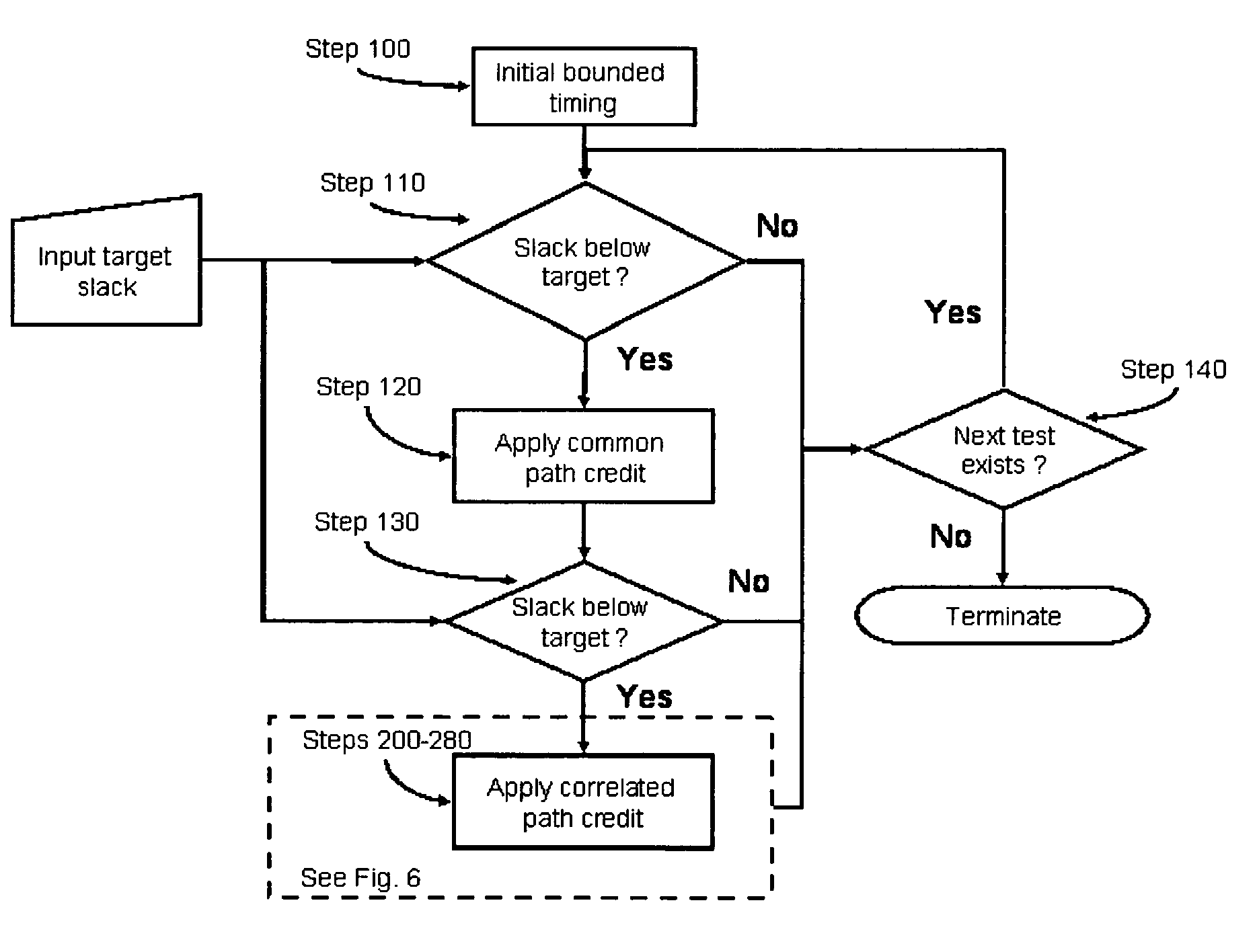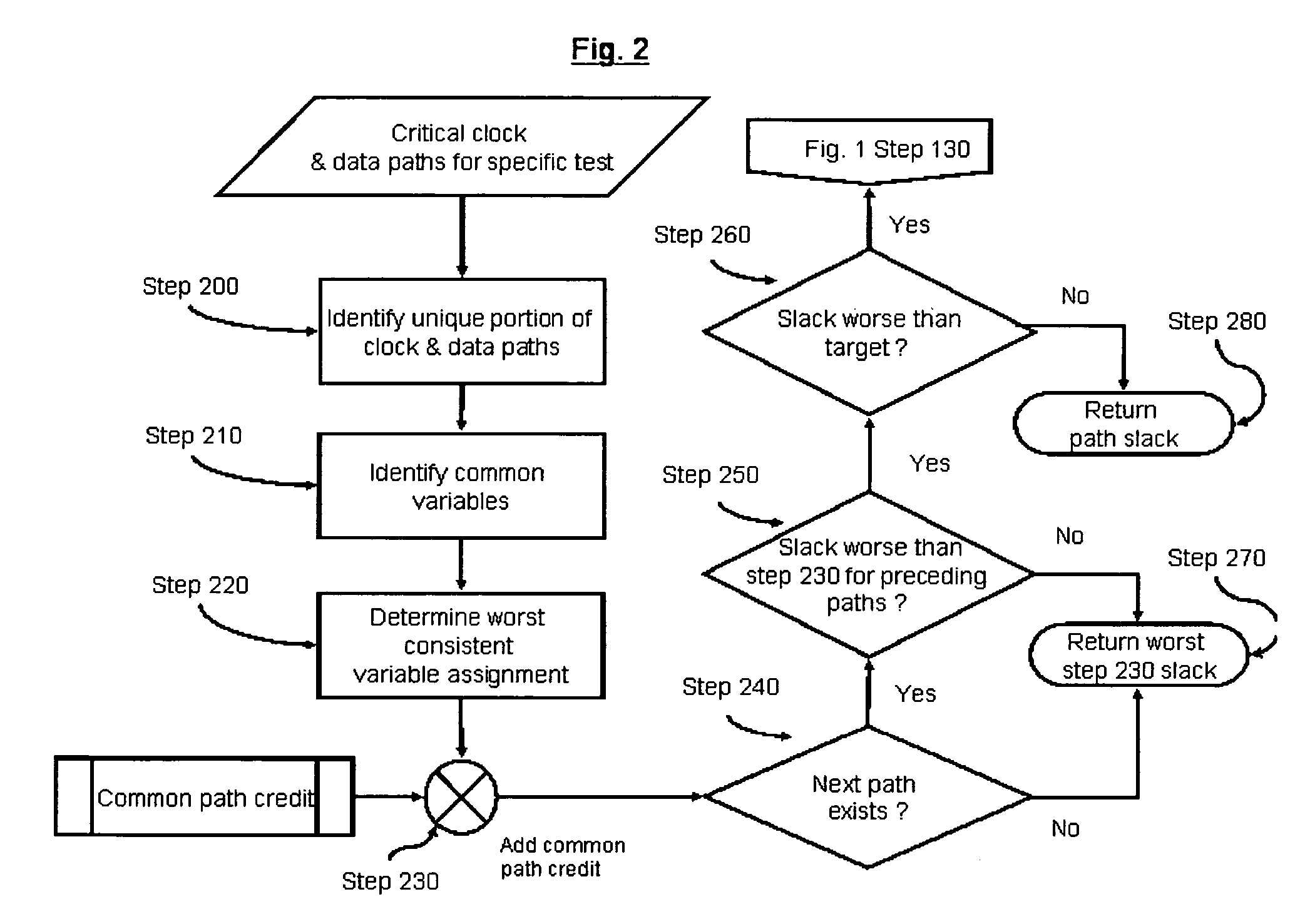System and method for correlated process pessimism removal for static timing analysis
a static timing analysis and process pessimism technology, applied in the field of electronic design automation, can solve the problems of preventing the correct data from being stored in the storage element, and data may still become unstable, so as to reduce the pessimism
- Summary
- Abstract
- Description
- Claims
- Application Information
AI Technical Summary
Benefits of technology
Problems solved by technology
Method used
Image
Examples
first embodiment
[0080]In the invention, the unique clock and data paths are re-analyzed for all combinations of common parameter settings.
[0081]In the illustrative circuit, the following eight parameter combinations are applied to the unique clock and data paths (BOX320, BOX330) and (BOX340, BOX350)[0082]1. Xglobal_max, Yglobal_max, Zglobal_max[0083]2. Xglobal_max, Yglobal_max, Zglobal_min[0084]3. Xglobal_max, Yglobal_min, Zglobal_max[0085]4. Xglobal_max, Yglobal_min, Zglobal_min[0086]5. Xglobal_min, Yglobal_max, Zglobal_max[0087]6. Xglobal_min, Yglobal_max, Zglobal_min[0088]7. Xglobal_min, Yglobal_min, Zglobal_max[0089]8. Xglobal_min, Yglobal_min, Zglobal_min
[0090]For parameters which are not common to both, the unique data and clock paths (in the illustrative circuit, W and V) are left in their initial bounding state.
[0091]For each of the aforementioned combinations, a new test slack is computed by propagating the original arrival times from the closest common clock / data point (in the illustrativ...
second embodiment
[0103]In the invention, consistent corners are selected for a limited set of parameters, e.g., those having the largest impact on delay, while the others remain in a bounded state. If the resulting slack is above the target slack, no further exploration of parameter combinations for the current path-pair is required; otherwise, additional variables may be successively explored until the slack threshold is met.
[0104]In the illustrative circuit, for the first critical data path, an initial expansion for parameter X considers the following combinations:[0105]Data path: Xglobal_min, Yglobal_max, Zglobal_max[0106]versus[0107]Clock path: Xglobal_min, Yglobal_min, Zglobal_min[0108]Data path: Xglobal_max, Yglobal_max, Zglobal_max[0109]versus[0110]Clock path: Xglobal_max, Yglobal_min, Zglobal_min
[0111]The Xglobal_min combination resulting in a non-negative slack is computed as follows:
((15+15+30)−(30+30+15))=−15
Slack including common path credit=−15+15=0
[0112]Since this slack meets the speci...
third embodiment
[0125]In the invention, parameters that have a separable impact on delay are projected independently to a worst-case corner. Linear complexity per path is guaranteed for the variables which are separable, unlike previous embodiments, wherein exponential complexity is still possible in the worst case (i.e., if each parameter expansion produces a slack below the specified cutoff).
[0126]For the critical data and clock paths in the illustrative circuit, parameter X is assigned a value based on the worst slack among:[0127]Xglobal_max (all other parameters bounded)[0128]Data path: Xglobal_max, Yglobal_max, Zglobal_max[0129]Clock path: Xglobal_max, Yglobal_min, Zglobal_min
Slack=((15+20+30)−(30+40+15))=−20[0130]and[0131]Xglobal_min (all other parameters bounded)[0132]Data path: Xglobal_min, Yglobal_max, Zglobal_max[0133]Clock path: Xglobal_min, Yglobal_min, Zglobal_min
Slack=((15+15+30)−(30+30+15))=−15
[0134]In the present example, a consistent assignment of Xglobal_max generates the worst sl...
PUM
 Login to View More
Login to View More Abstract
Description
Claims
Application Information
 Login to View More
Login to View More - R&D
- Intellectual Property
- Life Sciences
- Materials
- Tech Scout
- Unparalleled Data Quality
- Higher Quality Content
- 60% Fewer Hallucinations
Browse by: Latest US Patents, China's latest patents, Technical Efficacy Thesaurus, Application Domain, Technology Topic, Popular Technical Reports.
© 2025 PatSnap. All rights reserved.Legal|Privacy policy|Modern Slavery Act Transparency Statement|Sitemap|About US| Contact US: help@patsnap.com



